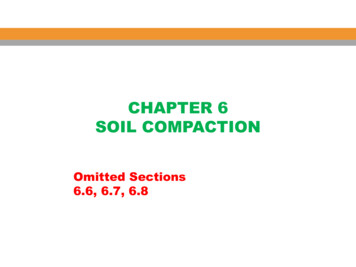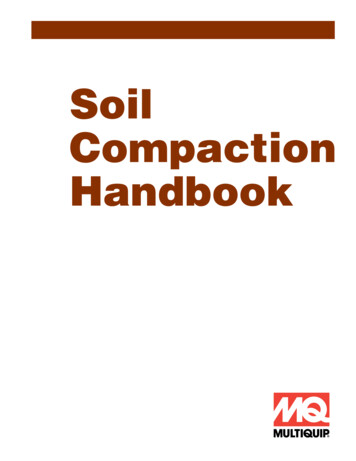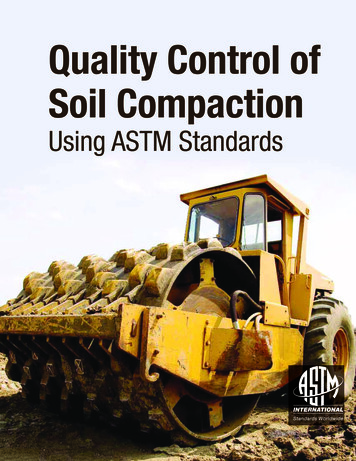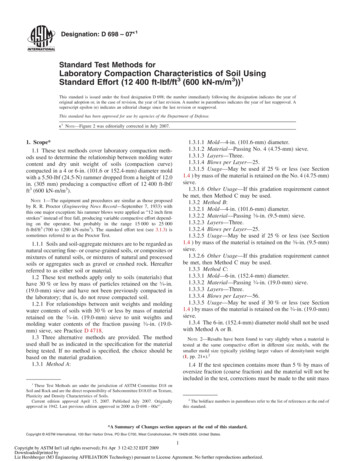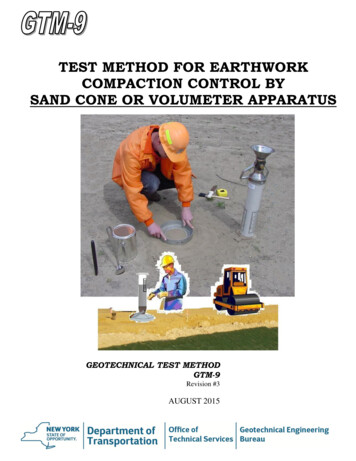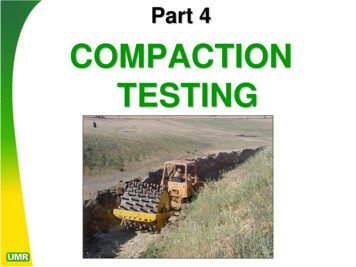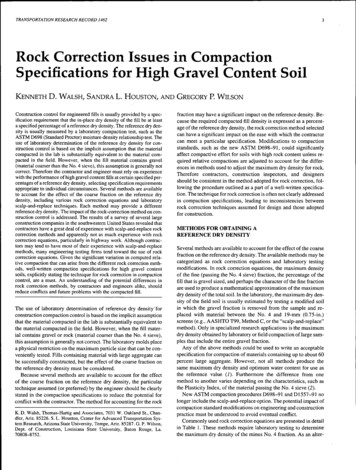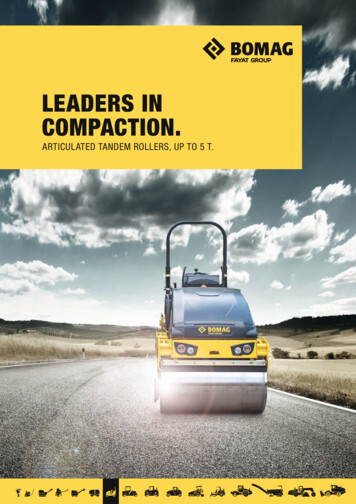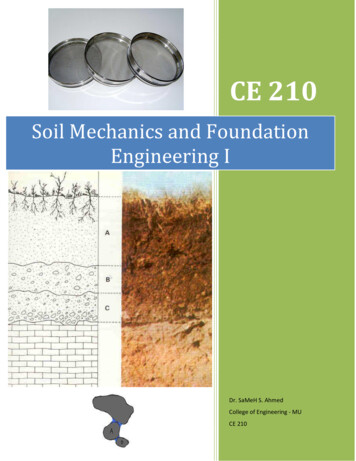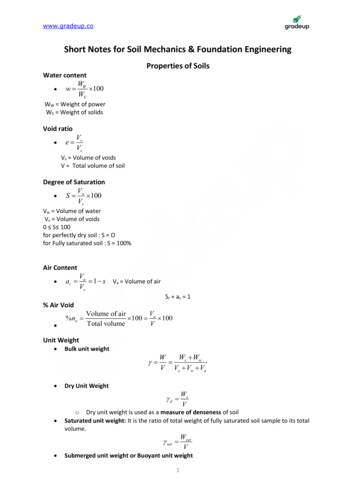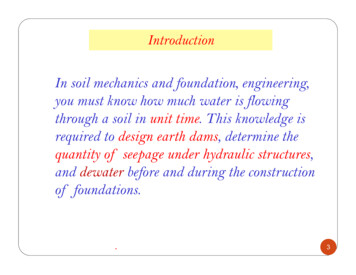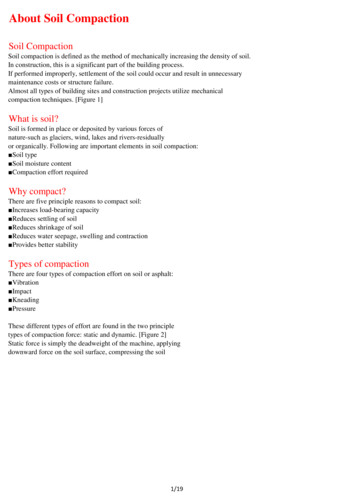
Transcription
About Soil CompactionSoil CompactionSoil compaction is defined as the method of mechanically increasing the density of soil.In construction, this is a significant part of the building process.If performed improperly, settlement of the soil could occur and result in unnecessarymaintenance costs or structure failure.Almost all types of building sites and construction projects utilize mechanicalcompaction techniques. [Figure 1]What is soil?Soil is formed in place or deposited by various forces ofnature-such as glaciers, wind, lakes and rivers-residuallyor organically. Following are important elements in soil compaction: Soil type Soil moisture content Compaction effort requiredWhy compact?There are five principle reasons to compact soil: Increases load-bearing capacity Reduces settling of soil Reduces shrinkage of soil Reduces water seepage, swelling and contraction Provides better stabilityTypes of compactionThere are four types of compaction effort on soil or asphalt: Vibration Impact Kneading PressureThese different types of effort are found in the two principletypes of compaction force: static and dynamic. [Figure 2]Static force is simply the deadweight of the machine, applyingdownward force on the soil surface, compressing the soil1/19
SOIL DENSITY [Figure1]particles. The only way to change the effective compactionforce is by adding or subtracting the weight of the machine.Static compaction is confined to upper soil layers and is limitedto any appreciable depth. Kneading and pressure are two examples of static compaction.Dynamic force uses a mechanism, usually engine-driven,to create a downward force in addition to the machine'sstatic weight. The vibrating mechanism is usually arotating eccentric weight or piston/spring combination (inrammers). The compactors deliver a rapid sequence ofblows (impacts) to the surface, thereby affecting the toplayers as well as deeper layers. Vibration moves throughthe material, setting particles in motion and moving themcloser together for the highest density possible. Based on thematerials being compacted, a certain amount of force must beused to overcome the cohesive nature of particular particles.2/19
BENEFITS OF SOIL COMPACTION [Figure3]Figure 3 — These illustrations show the results of impropercompaction and how proper compaction can ensure a longerstructural life, eliminating future foundation problems.Soil Types and ConditionsEvery soil type behaves differently with respect to maximumdensity and optimum moisture. Therefore, each soil type hasits own unique requirements and controls both in the field andfor testing purposes. Soil types are commonly classified bygrain size, determined by passing the soil through a series ofsieves to screen or separate the different grain sizes.[See Figure 4]Soil classification is categorized into 15 groups, a system setup by AASHTO (American Association of State Highway andTransportation Officials). Soils found in nature are almost always a combination of soil types. A well-graded soil consistsof a wide range of particle sizes with the smaller particlesfilling voids between larger particles. The result is a densestructure that lends itself well to compaction.A soil's makeup determines the best compaction method to use.There are three basic soil groups: Cohesive Granular Organic (this soil is not suitable for compaction and will not be discussed here)3/19
SIEVE TEST [Figure4]Cohesive soilsCohesive soils have the smallest particles. Clay has a particlesize range of .00004" to .002". Silt ranges from .0002" to .003".Clay is used in embankment fills and retaining pond beds.CharacteristicsCohesive soils are dense and tightly bound together bymolecular attraction. They are plastic when wet and canbe molded, but become very hard when dry. Proper watercontent, evenly distributed, is critical for proper compaction.Cohesive soils usually require a force such as impact orpressure. Silt has a noticeably lower cohesion than clay.However, silt is still heavily reliant on water content.4/19
Granular soilsGranular soils range in particle size from .003" to .08" (sand)and .08" to 1.0" (fine to medium gravel). Granular soils areknown for their water-draining properties.CharacteristicsSand and gravel obtain maximum density in either a fully dryor saturated state. Testing curves are relatively flat so densitycan be obtained regardless of water content.The tables on the following pages give a basic indicationof soils used in particular construction applications. [See Figures 5, 6 & 7]GUIDE TO SOIL TYPES [Figure 5]What to look forGranular soils, finesands and gravel.Cohesive soils,clays, silts andmixed soils.Appearance/feelCoarse grains canbe seen. Feels grittywhen rubbedbetween fingers.Water movementWhen water andsoil are shaken inpalm of hand, theymix. Whenshaking isstopped, theyseparate.Grains cannot beWhen water andseen by naked eye. soil are shaken inFeels smooth and palm of hand, theygreasy whenwill not mix.rubbed betweenfingers.When moist. When dry.Very little or Little or no cohesiveno plasticity. strength when dry.Soil sample willcrumble easily.Plastic andHas high strengthsticky. Can be when dry. Crumblesrolled.with difficulty. Slowsaturation in water.5/19
RELATIVE DESIRABILITY OF SOILS AS COMPACTED FILL [Figure6 ]MATERIALS [Figure 7]PermeabilityGRAVELSANDSILTCLAYORGANICVery HighMediumMedium LowNone LowFoundationSupportExcellentGoodPoorModerateNot tionDifficultyVery EasyEasySomeVery DifficultImpossible
Effect of moistureThe response of soil to moisture is very important, as thesoil must carry the load year-round. Rain, for example, maytransform soil into a plastic state or even into a liquid. In thisstate, soil has very little or no load-bearing ability.Moisture soil densityMoisture content of the soil is vital to proper compaction.Moisture acts as a lubricant within soil, sliding the particlestogether. Too little moisture means inadequate compactionthe particles cannot move past each other to achieve density.Too much moisture leaves water-filled voids and subsequentlyweakens the load-bearing ability. The highest density for mostsoils is at a certain water content for a given compaction effort.The drier the soil, the more resistant it is to compaction. In awater-saturated state the voids between particles are partiallyfilled with water, creating an apparent cohesion that bindsthem together. This cohesion increases as the particle sizedecreases (as in clay-type soils). [See Figure 8]MOISTURE VS SOIL DENSITY [Figure 8]Soil density testsTo determine if proper soil compaction is achieved for anyspecific construction application, several methods weredeveloped. The most prominent by far is soil density.Why testSoil testing accomplishes the following: Measures density of soil for comparing the degree of compaction vs specs Measures the effect of moisture on soil density vs specs Provides a moisture density curve identifying optimum moisture.7/19
HAND TEST [Figure 9]A quick method of determining moisture density is known as the "Hand Test."Pick up a handful of soil. Squeeze it in your hand. Open your hand.Figure 9If the soil is powdery and will not retain the shape made by yourhand, it is too dry. If it shatters when dropped, it is too dry.If the soil is moldable and breaks into only a couple of pieceswhen dropped, it has the right amount of moisture for proper compaction.If the soil is plastic in your hand, leaves small traces of moistureon your fingers and stays in one piece when dropped, it has toomuch moisture for compaction.Types of testsTests to determine optimum moisture content are done inthe laboratory. The most common is the Proctor Test, orModified Proctor Test. A particular soil needs to have anideal (or optimum) amount of moisture to achieve maximumdensity. This is important not only for durability, but will savemoney because less compaction effort is needed to achieve the desired results.Proctor Test [ASTM D1557-91]The Proctor, or Modified Proctor Test, determines themaximum density of a soil needed for a specific job site. Thetest first determines the maximum density achievable for thematerials and uses this figure as a reference. Secondly, ittests the effects of moisture on soil density. The soil referencevalue is expressed as a percentage of density. These valuesare determined before any compaction takes place to developthe compaction specifications. Modified Proctor values arehigher because they take into account higher densities neededfor certain types of construction projects. Test methods aresimilar for both tests. [See Figure 10]Field testsIt is important to know and control the soil density duringcompaction. Following are common field tests to determineon the spot if compaction densities are being reached.8/19
PROCTOR TEST [Figure 10]FIELD DENSITY TESTING METHODS [Figure 11]9/19
SAND CONE TEST [ Figure12 ]Sand Cone Test (ASTM D1556-90)A small hole (6" x 6" deep) is dug in the compacted materialto be tested. The soil is removed and weighed, then driedand weighed again to determine its moisture content. A soil'smoisture is figured as a percentage. The specific volume ofthe hole is determined by filling it with calibrated dry sand froma jar and cone device. The dry weight of the soil removed isdivided by the volume of sand needed to fill the hole. Thisgives us the density of the compacted soil in lbs per cubicfoot. This density is compared to the maximum Proctor densityobtained earlier, which gives us the relative density of the soilthat was just compacted. [See Figure 12]Nuclear Density (ASTM D2922-91)Nuclear Density meters are a quick and fairly accurate wayof determining density and moisture content. The meter usesa radioactive isotope source (Cesium 137) at the soil surface(backscatter) or from a probe placed into the soil (directtransmission). The isotope source gives off photons (usuallyGamma rays) which radiate back to the meter's detectorson the bottom of the unit. Dense soil absorbs more radiationthan loose soil and the readings reflect overall density. Watercontent (ASTM D3017) can also be read, all within a few10/19
minutes. A relative Proctor Density is obtained after comparingmaximum density with the compaction results from the test.[See Figure 13]NUCLEAR TEST [ Figure13 ]Soil Modulus (soil stiffness)This field-test method is a very recent development thatreplaces soil density testing. Soil stiffness is the ratio of forceto-displacement. Testing is done by a machine that sendsvibrations into the soil and then measures the deflection ofthe soil from the vibrations.This is a very fast, safe method of testing soil stiffness. Soilstiffness is the desired engineering property, not just drydensity and water content. This method is currently beingresearched and tested by the Federal Highway Administration.Compaction EquipmentApplicationsThe desired level of compaction is best achieved by matchingthe soil type with its proper compaction method. Other factorsmust be considered as well, such as compaction specs and job site conditions. Cohesive soils - clay is cohesive; its particles sticktogether.* Therefore, a machine with a high impact forceis required to ram the soil and force the air out, arrangingthe particles. A rammer is the best choice, or a pad-footvibratory rolled higher production is needed. [See Figure 14] Granular soils—since granular soils are not cohesiveand the particles require a shaking or vibratory action tomove them, vibratory plates (forward travel) are the best choice.11/19
RECOMMENDED EQUIPMENT FOR COHESIVE SOILS [Figure14]Figure14Reversible plates and smooth drum vibratory rollers areappropriate for production work. Granular soil particles respondto different frequencies (vibrations) depending on particlesize. The smaller the particle, the higher the frequencynecessary to move it. As you compact soils with larger particles,move up to larger equipment to obtain lower frequencies andhigher compaction forces. [See Figure 15]RECOMMENDED EQUIPMENT FOR GRANULAR SOILS [Figure15]Figure1512/19
Normally, soils are mixtures of clay and granular materials,making the selection of compaction equipment more difficult.It is a good idea to choose the machine appropriate for thelarger percentage of the mixture. Equipment testing may berequired to match the best machine to the job.Asphalt is considered granular due to its base of mixedaggregate sizes (crushed stone, gravel, sand and fines) mixedwith bitumen binder (asphalt cement). Consequently, asphaltmust be compacted with pressure (static) or vibration.Compaction machine characteristicsTwo factors are important in determining the type of force acompaction machine produces: frequency and amplitude.Frequency is the speed at which an eccentric shaft rotates orthe machine jumps. Each compaction machine is designedto operate at an optimum frequency to supply the maximumforce. Frequency is usually given in terms of vibrations per minute (vpm).Amplitude (or nominal amplitude) is the maximum movementof a vibrating body from its axis in one direction. Doubleamplitude is the maximum distance a vibrating body movesin both directions from its axis. The apparent amplitude variesfor each machine under different job site conditions. Theapparent amplitude increases as the material becomes moredense and compacted. [Figure 16]Figure 1613/19
LIFT HEIGHT [Figure17]Lift height and machine performanceLift height (depth of the soil layer) is an important factorthat affects machine performance and compaction cost.Vibratory and rammer-type equipment compact soil in thesame direction: from top to bottom and bottom to top. As themachine hits the soil, the impact travels to the hard surfacebelow and then returns upward. This sets all particles inmotion and compaction takes place.As the soil becomes compacted, the impact has a shorterdistance to travel. More f
Proctor Test [ASTM D1557-91] The Proctor, or Modified Proctor Test, determines the maximum density of a soil needed for a specific job site. The test first determines the maximum density achievable for the materials and uses this figure as a reference. Secondly, it tests the effects of moisture on soil density. The soil reference value is expressed as a percentage of density. These values are .
